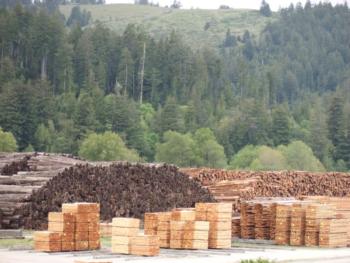Carbon Sequestration

The ‘forest carbon challenge’ is how to increase the total carbon benefits from forest storage, product storage and fossil fuel substitution benefits. This requires measuring not just the standing carbon (including the forest floor and underground carbon), but the future risks to forest carbon from wildfires, insects, and disease; the amount of carbon stored in products or in landfills, the life cycle benefits of harvested wood products compared to non-renewable products; and the energy produced from wood residues. In addition to the challenge of trying to estimate the future risk of forest carbon losses to wildfires, insects, and disease infestations, accurate estimates need to incorporate the rates of technological innovations with respect to the use of wood product and wood residue based energy. Not surprisingly, this task has proved to be technically very challenging and has slowed progress towards simple, transparent, and widely agreed upon approaches to the forest carbon challenge.
At the national level, estimates of all direct benefits are included in the national Greenhouse Gas Inventory. At the California level, the 2008 framework for greenhouse gas accounting for the forest and forest products sector seriously undercounts the carbon storage in products and landfills as well as the climate benefits of using woody residues to heat and generate electricity. A recent analysis ( Stewart_Nakamura_FPJ2012_FullGHG_Accounting ) using the national GHG inventory standards for harvested products from 17,000 acres in California documents climate benefits from sustainably harvested products that are four times as large as those considered under current California accounting rules.
Since the vast majority of these climate benefits show up in the energy and industrial processes chapters of the national GHG inventory, they are often ignored at the project accounting level. Since global climate benefits are only some of the many potential environmental impacts of increased woody biomass collection for bioenergy, there is interest in the full range of potential positive and negative environmental impacts. A 2011 review,
Potential Positive and Negative Environmental Impact of Increased Woody Biomass Use for California
- PIER Final Project Report. CEC-500-2011-036, provides summaries and a bibliography of recent work relevant to California.
To date, the global experiences with project level accounting of forest carbon offset projects has been that the transaction costs and time delays are very high and that the offset market price minus the offset project fees is often less than the stumpage value for most commercial species in accessible forests. However, the markets for project level offsets are still evolving in California, other states in the U.S., and foreign countries that could potentially sell carbon offsets into the California market.
UC Resources:
Northern California Society of American Foresters and UCCE 2015 webinar series on Forestry and Greenhouse Gas Reduction.
Stewart, William - Carbon calculator tracks the climate benefits of managed private forests
Stewart, William and Gary Nakamura. 2012. Documenting the Full Climate Benefits of Wood Products in Northern California - Linking Harvests to the US Greenhouse Gas Inventory . Forest Products Journal. 62/5. p 340-353.
Stewart, William, Robert F Powers, Kathryn McGown, Lindsay Chiono, and Teresa Chuang. 2011. Potential positive and negative environmental impacts of increased woody biomass use for California - PIER Final Project Report. CEC-500-2011-036. edited by CEC: Public Interest Energy Research. Sacramento, CA.
Forest Health and Carbon Storage in the Sierra Nevada - System Indicators: A final report to the Sierra Nevada Conservancy, December 2012. This reports on the status of Sierra Nevada forests from the standpoint of health, fire and carbon storage.
The June 2013 UCCE current forestry research webinar by Bill Stewart, 'A carbon calculator for sustainable forestry operations: working forests can outperform forest reserves' provides a global perspective on forest carbon and can be accessed here. Stewart carbon calculator June 2013
Other resources:
The Society of American Foresters has released a supplemental issue titled Managing Forests because Carbon Matters-Integrating Energy, Products and Land Management Policy in October 2011.
The 2007 report from the Intergovernmental Panel on Climate Change has a chapter on forestry describes how forests worldwide can be used to mitigate for climate change.
The US Forest Service has released a report on the economic and environmental benefits of using wood products in green building construction. Here is the 2011 USFS green-building-report .
Forest related climate benefits at the national level are covered in the forestry, energy, and waste chapters of the U.S. Greenhouse Gas Inventory.
State of California reports on forest related climate benefits are being constantly updated and can be accessed at the Climate Change Programs site.
